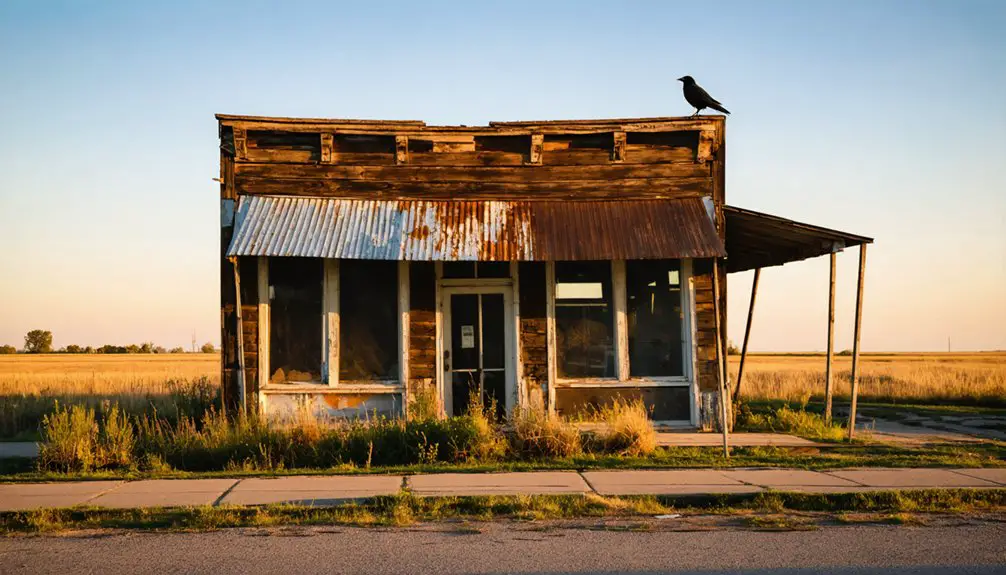You’ll find Dale’s remnants in Highland Grove Township, where Ole Gol’s saloon first established the village in 1910. This once-vibrant agricultural hub featured a town hall, jail, post office, and general store, serving as an essential trading post between settlers and Native Americans. By the mid-20th century, declining rail traffic led to Dale’s abandonment, though weathered buildings and scattered foundations still whisper stories of frontier life and cultural exchange.
Key Takeaways
- Dale was established in 1910 in Highland Grove Township, Minnesota, beginning with Ole Gol’s saloon relocated from Winnipeg Junction.
- The town flourished as an agricultural hub with essential structures including a general store, post office, grain elevator, and trading post.
- The trading post employed eighteen Native Americans by 1929, serving as a vital connection between settlers and Indigenous peoples.
- Dale’s decline began in the mid-20th century with the closure of key infrastructure and reduced rail traffic.
- Today, only deteriorating buildings and scattered foundations remain, providing archaeological evidence of the former settlement’s history.
The Birth of a Frontier Village
When Andrew L. Selsing relocated Ole Gol’s saloon from Winnipeg Junction to Dale in 1910, you wouldn’t have known this small patch of Minnesota prairie would become a frontier settlement.
The village emerged in section 34 of Highland Grove Township, where early settlers faced the typical frontier challenges of establishing a new community from scratch.
You’d have witnessed the gradual rise of significant structures that marked Dale’s transformation into a proper village. A town hall served as the center of civic life, while a jail maintained order. Like many frontier towns, Dale experienced a period of growth similar to when over 100,000 settlers moved into southeastern Minnesota territories.
The construction of a grain elevator proved essential for local farmers, and residential houses began dotting the landscape. The establishment of a post office cemented Dale’s position as a small but important hub supporting the agricultural activities of Clay County’s pioneering residents. The local general store became a cornerstone of daily life, having been one of the first establishments in Dale.
A Trading Post on the Prairie
Among Dale’s most significant establishments, the trading post served as both the economic engine and social heart of the community.
Similar to White Earth Road, the trading post connected vital supply routes through the region. You’d find everything from basic food staples to gasoline, cloth, and sewing supplies within its walls. Licensed by the Bureau of Indian Affairs, the post facilitated essential trading practices between settlers and Indigenous peoples.
The trading post’s operators maintained careful relationships with both Native Americans and frontier families, becoming influential figures in Dale’s development. By 1929, the business had grown to employ eighteen Native men in various roles.
They didn’t just run a store – they created a crucial hub where cultures intersected and commerce flourished. As one of the few commercial establishments for miles around, the post’s strategic location made it indispensable to the region’s survival, fostering Indigenous relations and helping to sustain the isolated prairie community through its daily operations.
Community Life and Social Gatherings
Life in Dale centered around several key gathering spots that knit the small farming community together.
You’d find residents congregating at the community hall for town meetings and seasonal celebrations, while the relocated saloon from Winnipeg Junction served as a hub for storytelling and entertainment.
The village store, established by Andrew L. Selsing, became a focal point where you could catch up with neighbors during daily trades.
The store wasn’t just for shopping – it was where daily life unfolded as neighbors met and shared community news.
Social dynamics revolved around the agricultural calendar, with community gatherings often coinciding with harvest seasons at the grain elevators.
Like many bustling mining towns, Dale’s transformation into a ghost town reflects Minnesota’s shifting economic landscape.
The post office, operational until 1971, served as a crucial connection point for Dale’s residents.
Though the town’s population eventually dwindled to just 20 people by 1990, these gathering places fostered tight-knit relationships among neighbors until the end.
The once-bustling community began its decline when the train stopped service, causing many residents and businesses to relocate elsewhere.
Agriculture and Local Commerce
Dale’s agricultural economy thrived around its bustling grain elevator, where local farmers brought their harvests for storage and rail transport.
You’d find families operating small farms focused on grain production, with many shifting from wheat monoculture to more diverse crops by the late 1800s. Like many declining towns, Dale faced economic shifts that transformed the rural landscape. As dairy farming grew in popularity across Clay County, Dale’s farmers adapted to meet changing market demands. The fertile valley soil supported the area’s agricultural success.
Andrew L. Jelsing’s general store and saloon served as the heart of local commerce, providing essential goods to both villagers and farmers.
Through the BNSF rail line, you could ship your agricultural products to major markets in Moorhead, Duluth, and Minneapolis. This crucial transportation link sustained Dale’s economy until post-WWII changes in farming and population patterns led to the town’s eventual decline.
Key Buildings and Infrastructure
The physical landscape of Dale tells the story of a once-thriving agricultural community through its remaining structures and foundations.
You’ll find key architectural features typical of Minnesota’s small towns, including the remnants of a jail, town hall, and post office that once served as the backbone of local governance and communication. The town’s most prominent structure was its grain elevator, which played a crucial role in agricultural commerce. Similar to Taconite Harbor’s decline, many families moved their homes away after receiving offers to buy them for one dollar. Access to natural resources and water was crucial for Dale’s initial establishment and growth.
Dale’s civic buildings and towering grain elevator stand as silent witnesses to a bustling agricultural community’s past life and purpose.
Like many ghost towns in the region, Dale’s residential area featured worker homes arranged in a grid pattern, though you won’t see much of them today.
Historic preservation efforts haven’t saved most structures from decay, as nature has reclaimed the sites. What remains are mainly foundations and traces of infrastructure that hint at Dale’s former significance as an agricultural hub.
Transportation Links and Regional Connections
While many ghost towns fade into obscurity, Dale’s strategic position along a major railway line shaped its rise and eventual decline.
You’ll find the town’s transportation evolution closely tied to the BNSF Railway tracks that still carry the Empire Builder through Clay County, though it no longer stops in Dale. The rail significance was crucial – the line connected Dale to major markets, enabling grain shipments and supporting local commerce.
Today, you can trace Dale’s former vibrancy through its remaining road network near Dale and Marshall streets.
While Detroit Lakes, about 20 miles away, maintains active rail service, Dale’s fate was sealed when its grain elevator closed in the early 1970s. Like many rural Minnesota communities, Dale couldn’t survive the shift from rail-dependent commerce to highway-based transportation.
The Path to Abandonment

As rail traffic diminished in the mid-20th century, multiple factors converged to accelerate Dale’s path toward abandonment.
Economic factors dealt the heaviest blows, with the closure of the town’s essential infrastructure – including its jail, post office, and grain elevator. You would’ve witnessed the ripple effects as businesses shuttered and jobs disappeared, triggering widespread population shifts away from the community.
The town’s decline mirrored a pattern seen across Minnesota’s ghost towns, where changing transportation routes and corporate decisions sealed their fates.
Once Dale’s grain elevator closed, you’d have seen families quickly relocate to areas with better prospects. Without its economic backbone and critical services, the town couldn’t sustain itself, and the exodus of residents marked its final descent into abandonment.
Present-Day Remnants and Historical Value
You’ll find a handful of old buildings still standing in Dale, offering a glimpse into this once-bustling township’s past.
The deteriorating structures, complete with boarded-up windows and weathered facades, stand alongside scattered foundations that mark where the town’s jail, post office, and grain elevator once operated.
These physical remnants, though limited in scope, provide valuable archaeological evidence for researchers studying Minnesota’s patterns of rural settlement and decline.
Surviving Buildings and Foundations
Despite years of abandonment, Dale’s remaining structures offer glimpses into Minnesota’s early settlement history.
You’ll find scattered stone and concrete foundations marking where the town’s essential buildings once stood – the jail, post office, and town hall. The architectural significance of these remnants lies in their early 20th-century foundation materials, which typically featured locally-sourced stone and timber construction.
While most wooden structures have vanished, the grain elevator’s heavy concrete base endures as a reflection of Dale’s agricultural heritage.
The foundations you’ll discover are positioned along former railroad corridors and civic zones, revealing the town’s original layout.
Though now overgrown, these weathered ruins serve as valuable artifacts for understanding rural Minnesota’s economic evolution and the freedom-seeking spirit of its early settlers.
Archaeological Evidence Today
Beyond Dale’s visible foundations, archaeological surveys have uncovered a rich tapestry of historical artifacts throughout the area.
You’ll find evidence of early settlement life through archaeological methods that reveal building debris, domestic items, and trade tools scattered across the landscape. While nature has reclaimed much of Dale’s surface features, careful artifact analysis continues to expose cellar holes, old roadbeds, and railroad remnants.
These discoveries tell a compelling story of cultural evolution, from Native American presence to European settlement.
The archaeological record shows how Dale’s residents lived through recovered household items like glassware, buttons, and ceramic fragments.
Through careful excavation and documentation, these material remains complement written histories and provide invaluable insights into the daily lives of Dale’s former inhabitants.
Frequently Asked Questions
What Was the Peak Population of Dale During Its Most Prosperous Years?
Through Dale’s history, population growth peaked between 100-200 residents during its prosperous years, with its town hall, jail, elevator, and post office serving the bustling agricultural community.
Were There Any Notable Crimes or Incidents Reported in Dale’s Jail?
You won’t find documented crime records or notable incidents from Dale’s jail history – historical sources remain silent on specific arrests or detentions in this small rural community’s lockup.
Did Dale Have a School or Church During Its Active Years?
You won’t find definitive evidence of a Dale schoolhouse or church in historical records. While nearby ghost towns had these institutions, Dale’s documented structures only included a town hall, jail, and post office.
What Happened to the Original Residents When the Town Declined?
With 90% of Dale’s residents forced to leave, you’d find many families moved to nearby active towns during the town abandonment. Their resident migration followed railway routes to areas with better economic opportunities.
Are There Any Living Descendants of Andrew L. Jelsing Still in Minnesota?
You can’t conclusively determine if Jelsing’s descendants remain in Minnesota today, as family genealogy records are private after 1936, and historical records don’t track living relatives in public databases.
References
- https://quickcountry.com/minnesota-ghost-towns/
- https://quickcountry.com/minnesotas-abandoned-ghost-towns/
- http://wikimapia.org/13660641/Dale-Minnesota-Ghost-Town
- http://freepages.rootsweb.com/~gtusa/history/usa/mn.htm
- https://kids.kiddle.co/Dale
- https://www.mngoodage.com/voices/mn-history/2019/07/a-ghost-town-turned-history-site/
- https://www.mnhs.org/millelacs/learn/trading-post
- https://www.friendlyrider.com/DocumentCenter/View/4078/Wadena-County-History
- https://www.tiktok.com/@mnhs.info/video/7470194532043328811
- https://npshistory.com/publications/fous/material-cult-rpt-8.pdf



